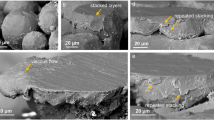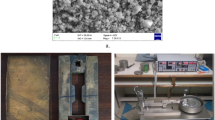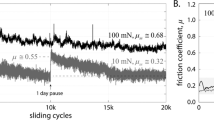Abstract
MECHANISMS postulated for the wear of hard crystalline surfaces by softer solids include thermal degradation1, diffusion and solution2; and self abrasion of the harder solid when its wear debris is picked up by the softer surface3. A mechanism based purely on mechanical aspects has not yet been established but there has been the suggestion of an ‘incubation period’ during which the structure of the hard solid has been modified before the onset of visible wear4. In earlier publications5,6, we have established that a dislocated zone was formed in some hard crystals by a softer slider, whenever the pressure between the contacting surfaces was greater than a certain threshold value which was thought to be related to the critical resolved shear stress. For a given load, and in these conditions, the depth of this zone was independent of the slider hardness—regardless of whether the point itself was blunted or visible macroscopic deformation and penetration of the harder crystal was obtained. Then, the depth of the dislocated zone was determined only by the magnitude of the applied load. There were two principal objectives to this particular study. First, to measure the effect of slider hardness on the number of traversals necessary to initiate visible fragmentation and wear in the harder crystal. Second, to use dislocation etching and microhardness techniques to follow the deformation of the harder crystal during the microdeformation preceding fracture—the incubation period.
This is a preview of subscription content, access via your institution
Access options
Subscribe to this journal
Receive 51 print issues and online access
$199.00 per year
only $3.90 per issue
Buy this article
- Purchase on Springer Link
- Instant access to full article PDF
Prices may be subject to local taxes which are calculated during checkout
Similar content being viewed by others
References
Bowden, F. P., and Scott, H. G., Proc. R. Soc., A258, 268 (1958).
Trent, E. M., Proc. R. Soc., A212, 467 (1952).
Bowden, F. P., and Tabor, D., Friction and Lubrication of Solids, Part 2, (Oxford Clarendon Press, 1964).
Crompton, D., Hirst, W., and Howse, M. G. W., Proc. R. Soc., A333, 435 (1973).
Brookes, C. A., and Green, P., Nature phys. Sci., 246, 119–122 (1973).
Brookes, C. A., Green, P., and Harrison, P. H., Diam. Res., 11, (1974).
Bowden, F. P., and Brookes, C. A., Proc. R. Soc., A295, 244 (1966).
Author information
Authors and Affiliations
Rights and permissions
About this article
Cite this article
BROOKES, C., SHAW, M. Cumulative deformation of magnesium oxide crystals by softer sliders. Nature 263, 760–762 (1976). https://doi.org/10.1038/263760a0
Received:
Accepted:
Issue Date:
DOI: https://doi.org/10.1038/263760a0
This article is cited by
-
Superhard materials: recent research progress and prospects
Science China Materials (2015)
Comments
By submitting a comment you agree to abide by our Terms and Community Guidelines. If you find something abusive or that does not comply with our terms or guidelines please flag it as inappropriate.



